We all have our quirks when it comes to language learning, right? Some folks swear by flashcards, others dive headfirst into grammar books, while people like me gravitate toward anything with music, TV shows, or engaging audio content. So when I stumbled across Language Transfer, I was naturally intrigued.
I mean, I can’t believe there’s this method that strips away all the bells and whistles—no fancy animations or gamified lessons. It's 100% based on audio instruction. It sounds promising, especially when I saw that zero-dollar price tag.
But here’s the million-dollar question: Is Language Transfer actually worth your time, or is it just another "free" tool that promises the world but leaves you nowhere near fluency?
To keep this review totally unbiased, I challenged myself to learn a completely new language: Greek. After weeks of testing Language Transfer’s method, I’m ready to share what really works, what doesn’t, and whether this audio-only approach can get you speaking a new language.
- Tandem Review: We Tested the App Everyone’s Comparing to Tinder
- Lingoda Review: Costly But Effective? Here’s the Truth!
- Mondly Review: Does Pearson’s AI-Powered App Live Up to the Hype?
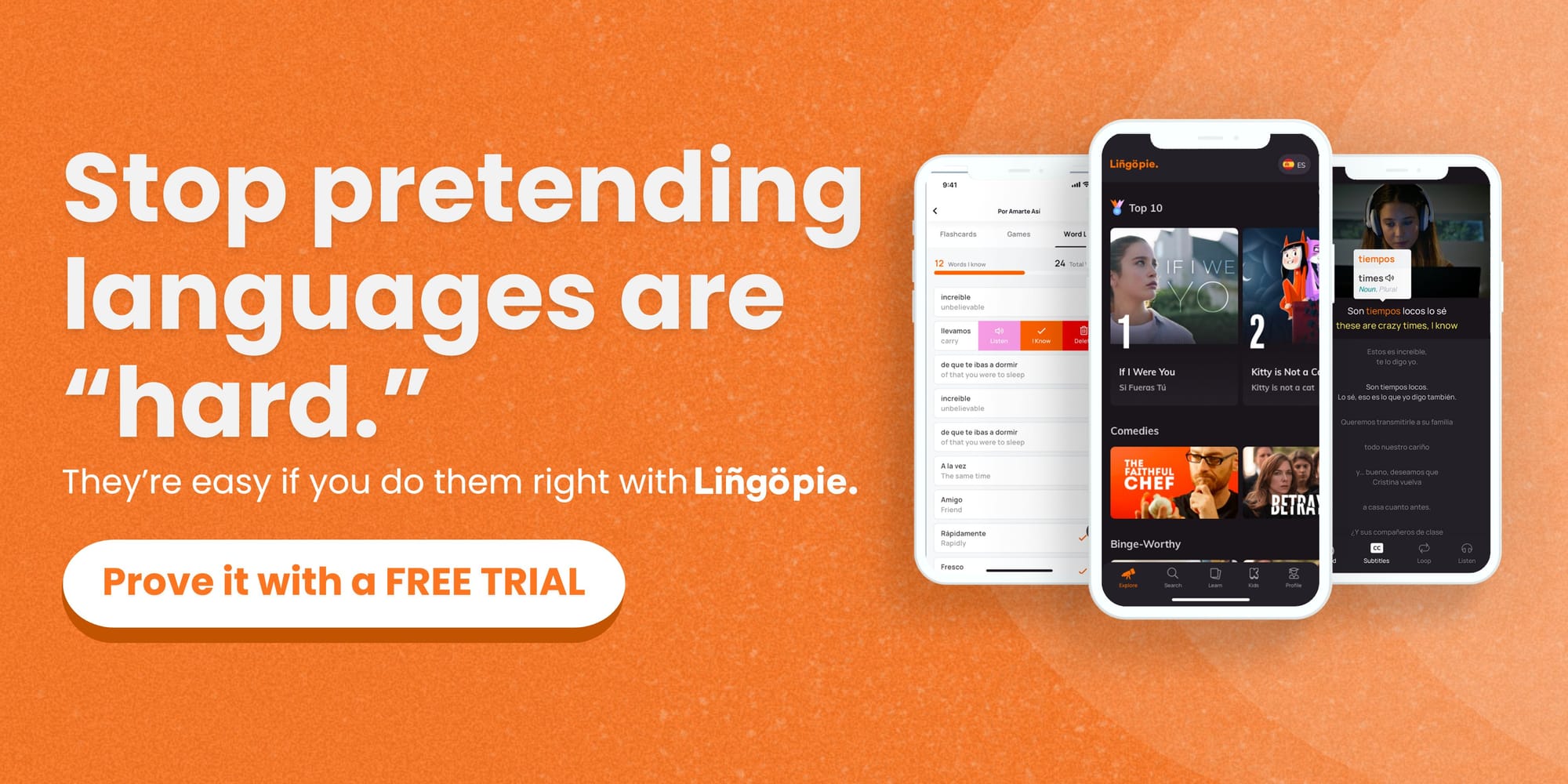
What Is Language Transfer?
Language Transfer is a completely free, audio-based language learning program created by Mihalis Eleftheriou. It is designed to help learners develop a deep understanding of their target language through "The Thinking Method," which emphasizes logical connections between the learner’s native language and the new one.
Instead of relying on rote memorization, it encourages learners to think through grammar and vocabulary patterns. The program offers high-quality introductory courses in eight languages and is accessible online for anyone looking to start learning a new language.
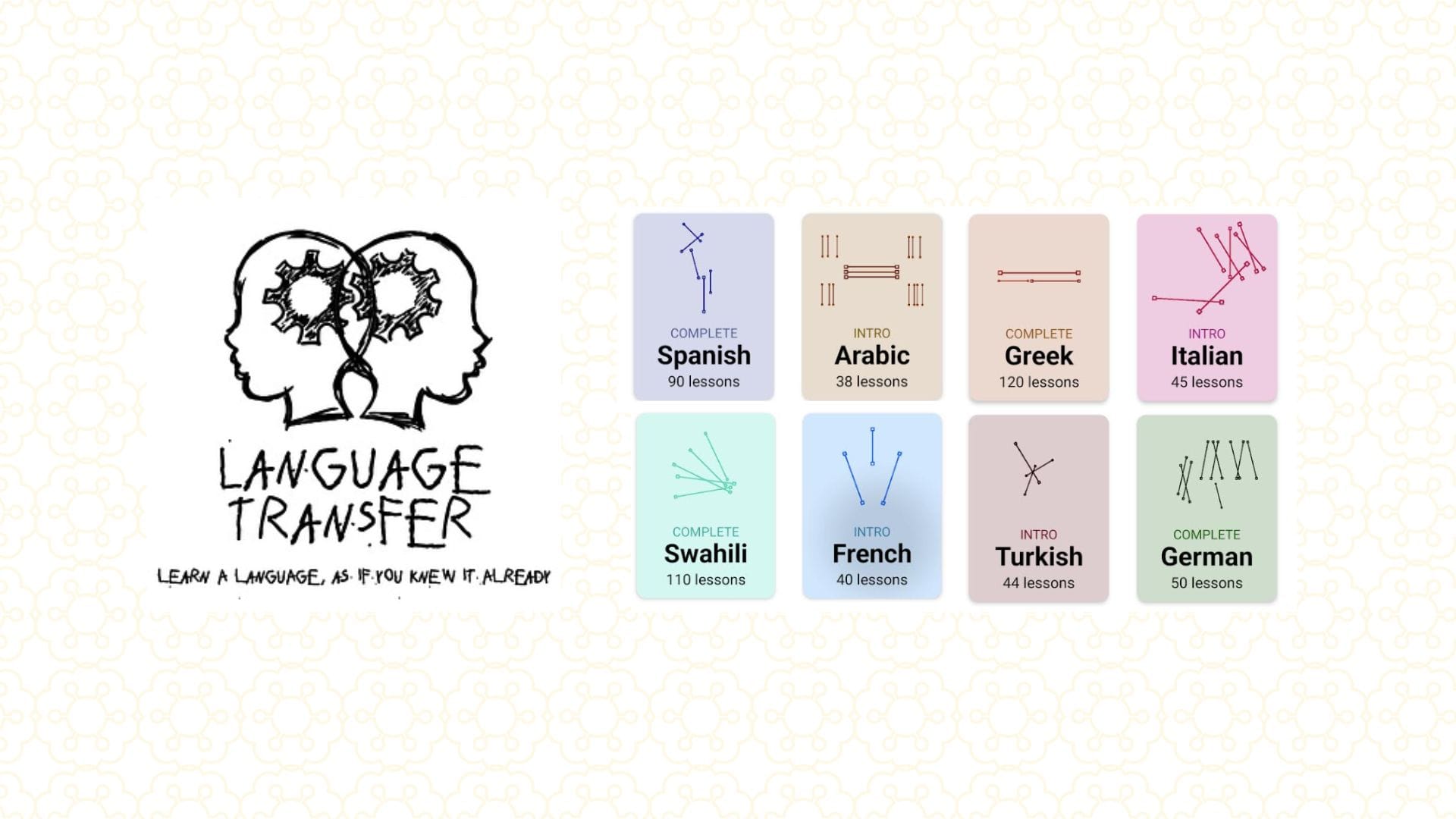
If Spanish is your native language, you can also take the free English course. Surprisingly, Language Transfer also includes a Music Theory course with 30 lessons, which honestly caught me off guard for a platform that’s supposed to be solely focused on language learning. But hey, maybe there’s some crossover between musical patterns and linguistic structures?
Given that it's audio-based learning similar to Pimsleur, I think Language Transfer works best as a foundational resource for beginners, but it really should be paired with visual resources like Lingopie or Duolingo for a more complete experience.
How To Use Language Transfer
Language Transfer is honestly one of the most straightforward language learning resources I've ever encountered. You literally don’t need to create an account, set up a profile, or worry about hitting a paywall halfway through your learning journey. There's no subscription trap, no "free trial" suddenly demanding your credit card, and no premium features locked behind a payment screen.
Instead, you can simply visit their website or download the mobile app and start learning immediately. It’s refreshingly simple given that most language apps want your email, phone number, and firstborn child before you can even see a single lesson.
Language Transfer App
Simply download it from your app store, open it up, select your target language, and start working through the lessons in order. The app itself is pretty lightweight, so it won't eat up tons of storage space on your phone.
One particularly handy feature is the ability to download audio lessons directly to your device, which means you can keep learning even when you’re offline or in areas with spotty internet connection. Perfect for commutes, flights, or those times when you want to squeeze in a lesson without burning through your data plan.
Language Transfer Web
The web version follows the same no-nonsense approach as the app. You don't need to create an account or provide any personal information whatsoever. Simply visit the Language Transfer website, choose your language, and start listening to lessons directly in your browser. It's particularly convenient if you prefer learning on a larger screen or want to switch between devices without worrying about syncing accounts or losing progress.
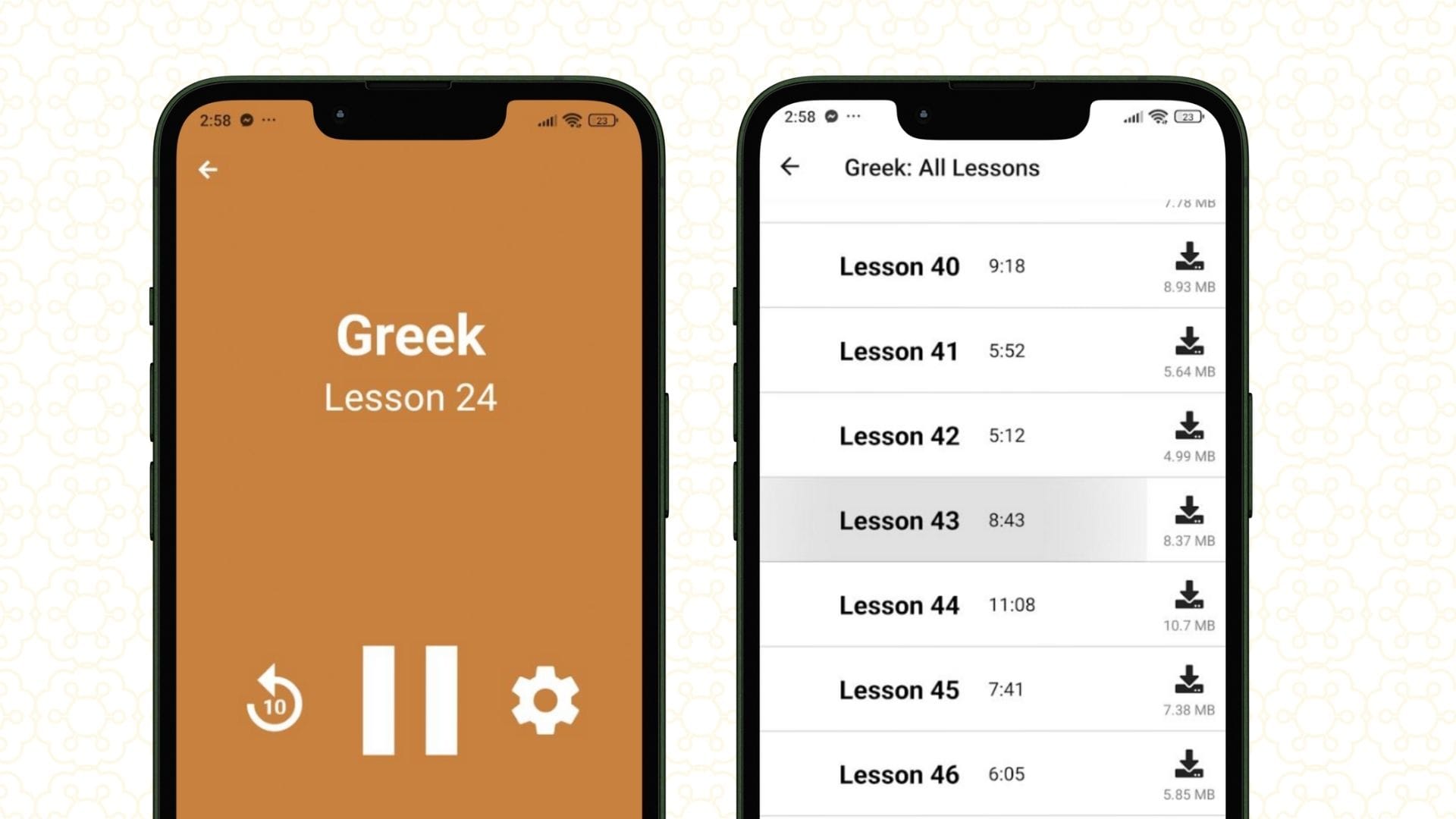
How Does Language Transfer Work?
The core philosophy behind Language Transfer is deceptively simple: listen, participate, and focus entirely on using your mind. Mihalis actively discourages you from writing down words, sentence structures, or taking traditional notes because he believes this will inhibit the mental processes needed to develop natural speaking abilities.
The idea is that by forcing your brain to work through the logical connections purely through audio, you’re training the same cognitive pathways you used as a child learning your native language.
So technically, you’re meant to pause when prompted, think through the answer in your head, and then continue listening to see if you got it right. It’s all about building that internal language processing system rather than relying on visual cues or written references.
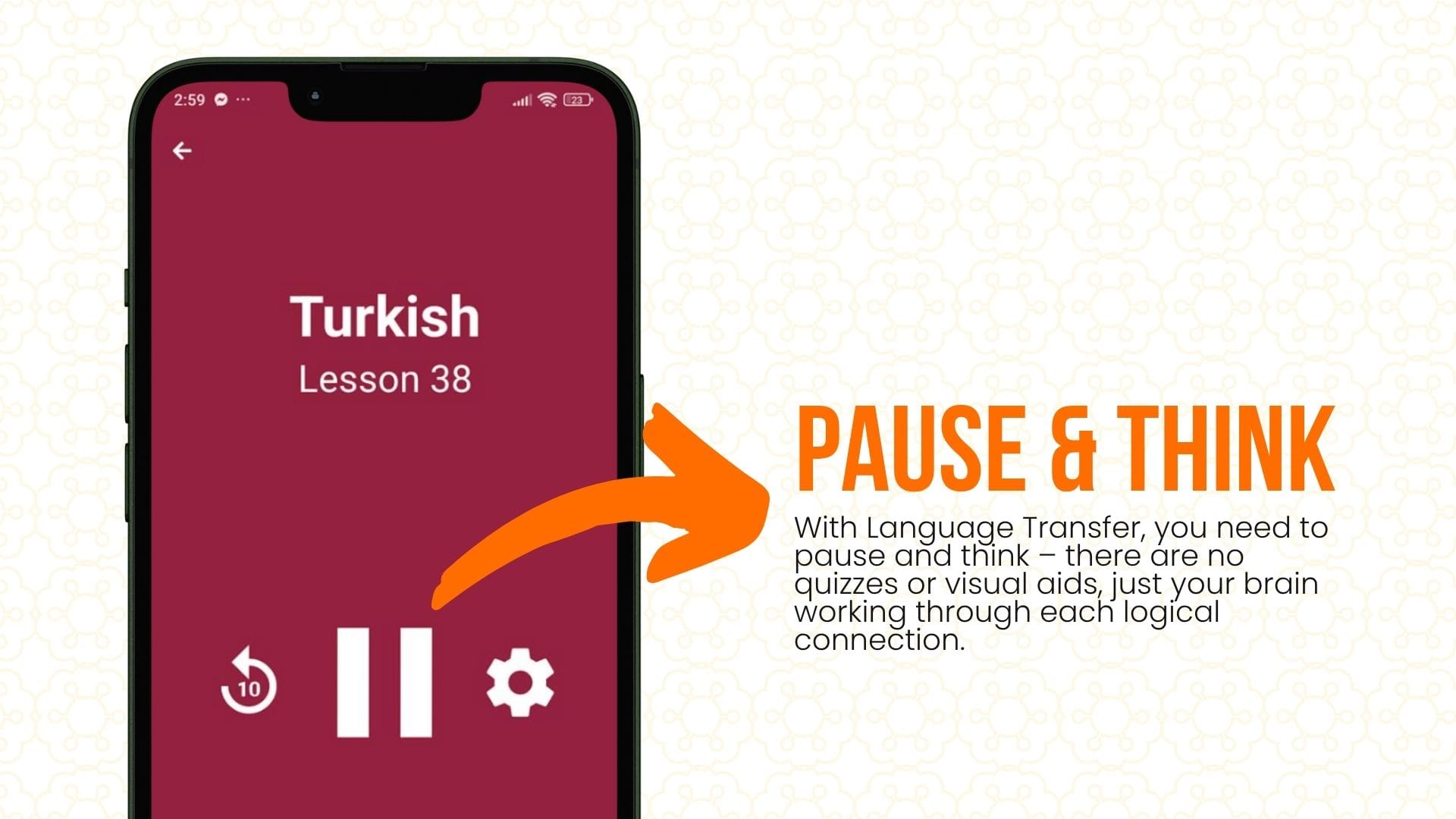
After completing the introductory lesson, the second lesson immediately throws you into learning basic words and phrases, which I found pretty effective. Over each six-minute lesson, you gradually absorb grammar structures through guided reasoning rather than memorization, and honestly, this approach clicked for me.
However, there are definitely moments when Mihalis references what certain letters of the Greek alphabet look like or how they’re pronounced. Since the course assumes zero prior knowledge, you can get a bit lost if you’re not familiar with the script from the start. I ended up keeping a simple Greek alphabet reference table handy on my phone, which helped me follow along when he mentioned specific letters or their visual appearance.
Language Transfer Review: Pros And Cons
Pros of Language Transfer
100% Free (And Actually Means It)
Language Transfer is genuinely, completely, no-strings-attached free. I've been through multiple lessons across different languages, and I've never once encountered a paywall, premium feature popup, or "upgrade now" button. This isn't some freemium model where the good stuff is locked behind a subscription. Every single lesson, every language course, and even that random music theory section are completely accessible without spending a dime.
For budget-conscious learners or people who want to test the waters before committing to paid resources, this is honestly a breath of fresh air. You can literally learn the fundamentals of a new language without any financial investment, which removes one of the biggest barriers to getting started.
No Filler Content
One thing that genuinely impressed me about Language Transfer is how dense and purposeful every single lesson feels. Even though it's just audio-based learning, I actually felt like I was absorbing more meaningful content compared to other language apps that pad their lessons with repetitive exercises or gamification elements.
There are also no pointless review sessions where you're matching the same five words over and over, no animated characters explaining basic concepts for the third time, and no artificial lengthening of lessons to make you feel like you're getting more value. Every minute of audio time is focused on teaching you something new or reinforcing previous concepts in a meaningful way.
When Mihalis says a six-minute lesson, you're getting six minutes of solid language instruction, not four minutes of actual learning wrapped in two minutes of interface navigation and motivational fluff.
High Quality Audio Production
The audio quality in Language Transfer is surprisingly professional, especially considering it's completely free. Mihalis has a clear, pleasant voice that’s easy to follow, and the recording quality is crisp without any distracting background noise or audio glitches. This might sound like a small detail, but when you're spending hours listening to someone guide you through language concepts, audio quality becomes crucial for maintaining focus and comprehension.
I've tried other free language resources where poor audio made it genuinely difficult to distinguish between similar sounds or understand pronunciation nuances. With Language Transfer, the production value feels more like what you’d expect from a premium course. The pacing is also well thought out, with appropriate pauses for you to process information and think through responses.
Cons of Language Transfer
Lack of Video, Visuals, or Any Downloadables to Support Learning
The biggest limitation I encountered with Language Transfer was the absence of visual learning materials. While the audio-only approach has merits, language learning naturally involves visual elements you can’t get through sound alone. There are no accompanying PDFs, visual grammar charts, alphabet guides, or downloadable reference materials to support what you’re hearing.
When Mihalis mentions how Greek letters look or explains a sentence’s visual structure, you’re left to imagine these concepts without any visual reinforcement. I found myself constantly pausing to look up Greek letters online or creating my own makeshift reference materials, which kind of defeats the purpose of the "no writing" philosophy. Visual learners might struggle with this limitation, as there's no way to see patterns, structures, or written examples that could help cement the audio lessons.
Lack of Speaking and Writing Skills Development
Language Transfer focuses exclusively on listening comprehension and internal mental processing, meaning two crucial language skills are completely ignored: speaking and writing. Throughout my Greek lessons, I was never once prompted to actually practice pronunciation or attempt to write anything down.
While Mihalis encourages you to think through responses, there's no feedback mechanism to tell you if your pronunciation is correct or if you're actually retaining the information properly. You're essentially learning to understand a language passively rather than actively using it.
For me, this creates a significant gap between what you can theoretically understand and what you can actually produce when it comes time to have a real conversation or write something in your target language.
Not a Holistic Language Learning Resource
Perhaps the most significant drawback is that Language Transfer simply can’t function as a complete language learning solution. While it excels at building logical foundations and helping you understand grammatical patterns, it completely lacks cultural context, authentic material, and real-world application. Aside from the Greek conversations between Mihalis and some students, you won't be exposed to contemporary expressions or cultural nuances.
The lessons exist in a vacuum without any connection to how native speakers actually use the language in everyday situations. This means you’ll need to supplement Language Transfer with other resources anyway, making it more of a stepping stone than a destination.
Language Transfer Vs Other Language Programs
Language Transfer Vs Pimsleur

Both use audio-only approaches, but Pimsleur costs around $150+ while Language Transfer is completely free. Pimsleur offers more structured pronunciation practice and spaced repetition, whereas Language Transfer focuses on logical reasoning through grammar patterns.
If you're budget-conscious and want to understand language logic, go with Language Transfer. If you need professional-grade pronunciation training and can afford it, Pimsleur wins.
Language Transfer Vs Lingopie

These serve completely different purposes. Language Transfer builds foundational grammar through audio lessons, while Lingopie provides authentic immersion through real TV shows and movies with interactive subtitles. Language Transfer lacks cultural context and authentic content that Lingopie excels at.
The ideal approach is to use Language Transfer to build your foundation, then switch to Lingopie for real-world immersion and cultural fluency.
Language Transfer Vs Duolingo
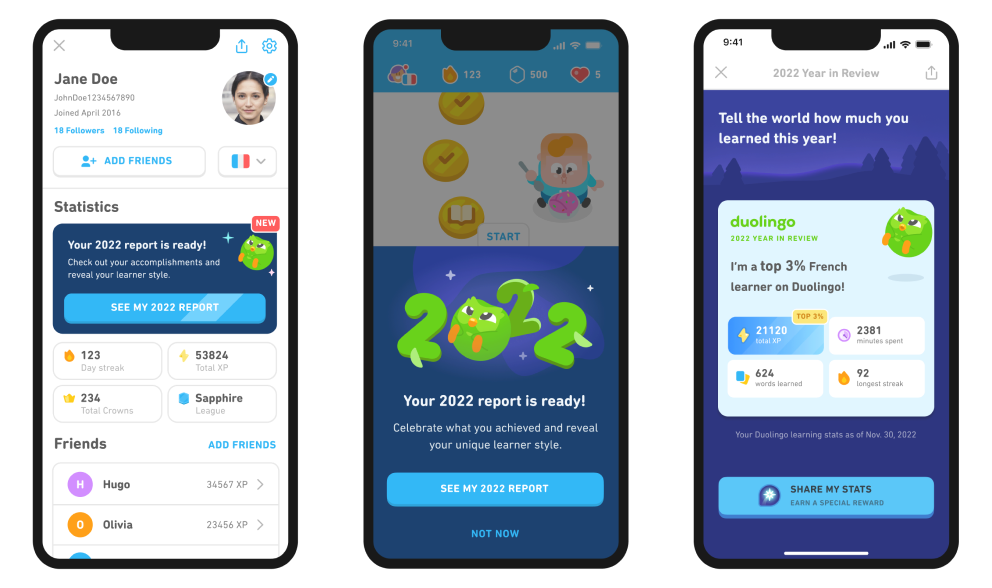
Duolingo gamifies learning with visual exercises, quizzes, and structured progression tracking, while Language Transfer relies purely on audio reasoning without any assessments. Duolingo covers reading, writing, and some speaking practice, but Language Transfer only develops listening comprehension and internal processing. Duolingo can feel repetitive with filler content, while Language Transfer delivers concentrated learning in shorter sessions.
For complete beginners who need visual reinforcement, Duolingo provides better structure.
So Is Language Transfer Worth It?
After spending weeks working through Greek lessons and testing Language Transfer's unique approach, here's my honest verdict: it's absolutely worth trying, but it's not a complete solution on its own.
Language Transfer excels at what it promises to do. The "Thinking Method" genuinely helps you understand grammar patterns and logical connections between languages in a way that feels natural and intuitive. If you're someone who learns well through audio and enjoys understanding the "why" behind language rules, you'll probably love this approach.
However, the complete lack of visual materials, speaking practice, cultural context, and authentic content means Language Transfer can only take you so far. You'll understand grammar patterns but won't be ready for actual conversations with native speakers or navigating real-world situations in your target language.
Personally, I prefer Lingopie's approach. Lingopie is the only resource that immerses you in authentic TV shows and movies where you actually hear how native speakers use the language in real situations. You get cultural context, natural pronunciation, and engaging content that makes learning feel less like work and more like entertainment.

Ready to Experience Real Language Immersion?
When learning a language, you need to note that immersion is everything. Immersion is how you can pick up natural rhythm, cultural nuances, and the confidence actually to speak like a native. The good news is that there's one tool that can give you that: Lingopie!
With Lingopie, you’re not just memorizing vocabulary or drilling grammar rules. You're absorbing authentic conversations through captivating TV shows and movies, learning how people talk when joking with friends, arguing with family, or falling in love.
Curious? Try Lingopie for FREE now by clicking below!


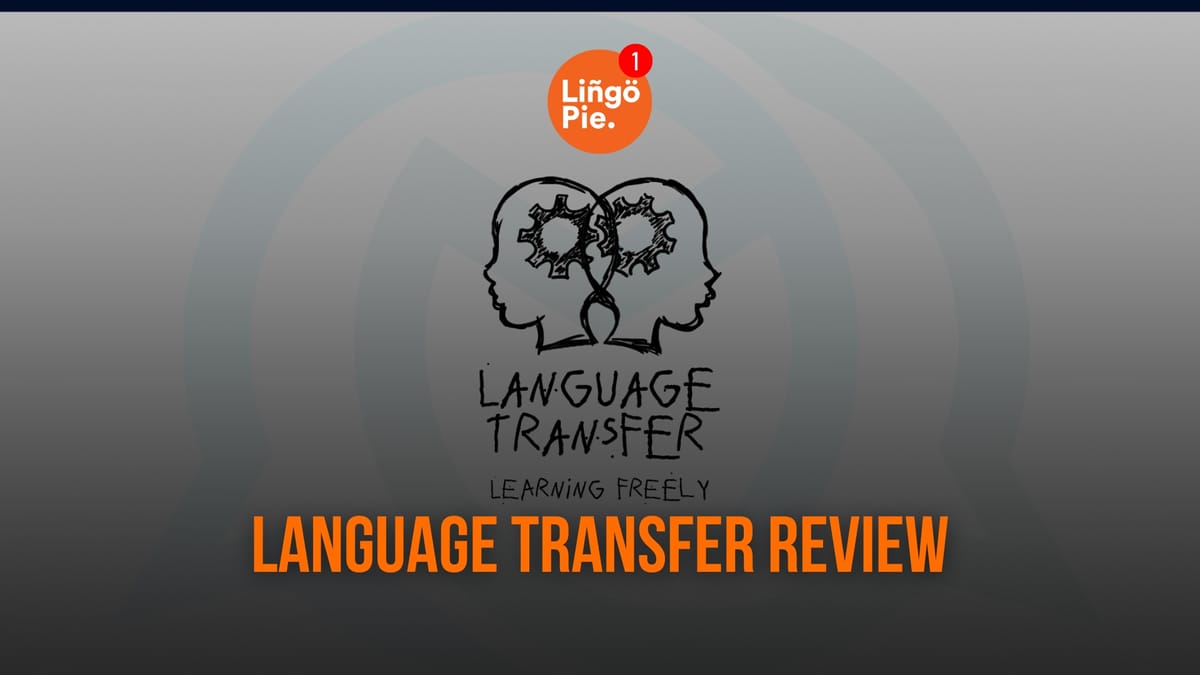

![How To Learn Norwegian As A Beginner: Tips + Guide [2026]](/blog/content/images/2025/07/Learn-norwegian-as-a-beginner.jpg)

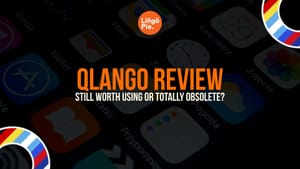
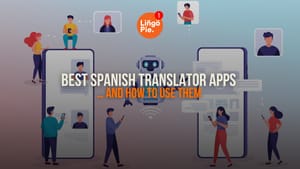
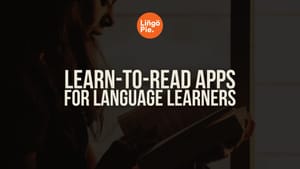
![Language Reactor Review: Why Lingopie Is The Better Choice for Language Learning [2026]](/blog/content/images/size/w300/2024/12/Language-Reactor-Review.jpg)